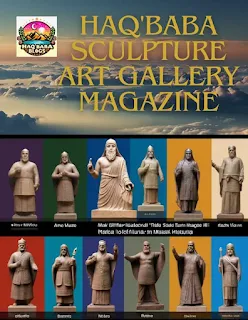HAQ'BABA Sculpture Art Gallery Magazine
HAQ'BABA Sculpture Art Gallery Magazine
A history of the art of sculpture
## A Profound Legacy: Unveiling the Historical Tapestry of Sculpture
Sculpture, the art of shaping three-dimensional forms, possesses a history as profound as human civilization itself. From the enigmatic figurines of the Paleolithic era to the thought-provoking installations of the modern world, sculptures have served as a powerful medium for expressing religious devotion, cultural identity, and artistic innovation across millennia.
The earliest sculptures, unearthed from the Paleolithic period, are often small, portable figures crafted from bone or stone. These enigmatic figurines, believed to be linked to fertility rituals and nascent religious practices, offer a fascinating glimpse into the early symbolic language employed by humankind.
As civilizations blossomed, so too did the art of sculpture. In ancient Egypt, monumental sculptures served as imposing testaments to pharaohs and deities. Hewn from granite or meticulously carved from limestone, these colossal figures embodied permanence and absolute power, reflecting the Egyptians' deeply held beliefs in the afterlife. Similarly, Mesopotamian sculptures, frequently crafted from bronze, depicted rulers and gods with a focus on strength and unwavering authority.
The classical period in Greece (5th-4th centuries BCE) witnessed a groundbreaking shift in sculptural representation. Greek sculptors, eschewing the rigid, stylized forms favored by earlier cultures, embraced naturalism and meticulous anatomical accuracy. Works like the "Venus de Milo" and the "Discobolus" showcased the human form in idealized perfection, reflecting the Greek preoccupation with balance, harmony, and ideal proportions.
The Roman Empire, heavily influenced by Greek artistic traditions, adopted and reinterpreted many sculptural styles. Roman portraiture, renowned for its lifelike depictions of emperors and ordinary citizens, captured individual personalities and nuanced characteristics. Relief sculptures adorned public buildings, commemorating victories and significant historical events.
The rise of Christianity in the late Roman Empire ushered in a new era in sculpture. Religious figures dominated artistic expression, often rendered in a more symbolic and spiritual style compared to the realistic forms of the classical period. Gothic art, flourishing in medieval Europe, further emphasized religious themes. Sculptors focused on conveying the emotional and spiritual aspects of faith, with elongated figures and dramatic drapery.
The Renaissance (14th-16th centuries CE) marked a resolute return to classical ideals in sculpture. Artists like Michelangelo and Donatello revived the focus on anatomy and naturalism, while infusing their work with a newfound depth of emotion and dynamism. This period also witnessed a surge in secular sculpture, with busts and statues commissioned to celebrate wealthy patrons and military heroes.
The subsequent centuries witnessed a multitude of stylistic movements in sculpture. Baroque artists like Bernini employed dramatic gestures and theatrical compositions to evoke powerful emotions. The Neoclassical period saw a renewed interest in Greek and Roman forms, while Romanticism favored emotional expression and historical narratives.
The 20th century revolutionized the very definition of sculpture. Modernist sculptors like Constantin Brancusi challenged traditional notions of representation, embracing abstraction and experimentation with novel materials. Kinetic sculptures introduced the element of movement, while installations blurred the boundaries between sculpture and environment.
Today, sculpture continues to evolve, incorporating cutting-edge technologies, innovative materials, and evolving artistic concepts. From the monumental public works of Alexander Calder to the thought-provoking site-specific installations of contemporary artists, sculpture remains a vibrant and ever-changing art form. As we delve into its rich history, we recognize sculpture's enduring power to capture the essence of human experience, cultural identity, and imaginative expression.


.jpg)


Comments